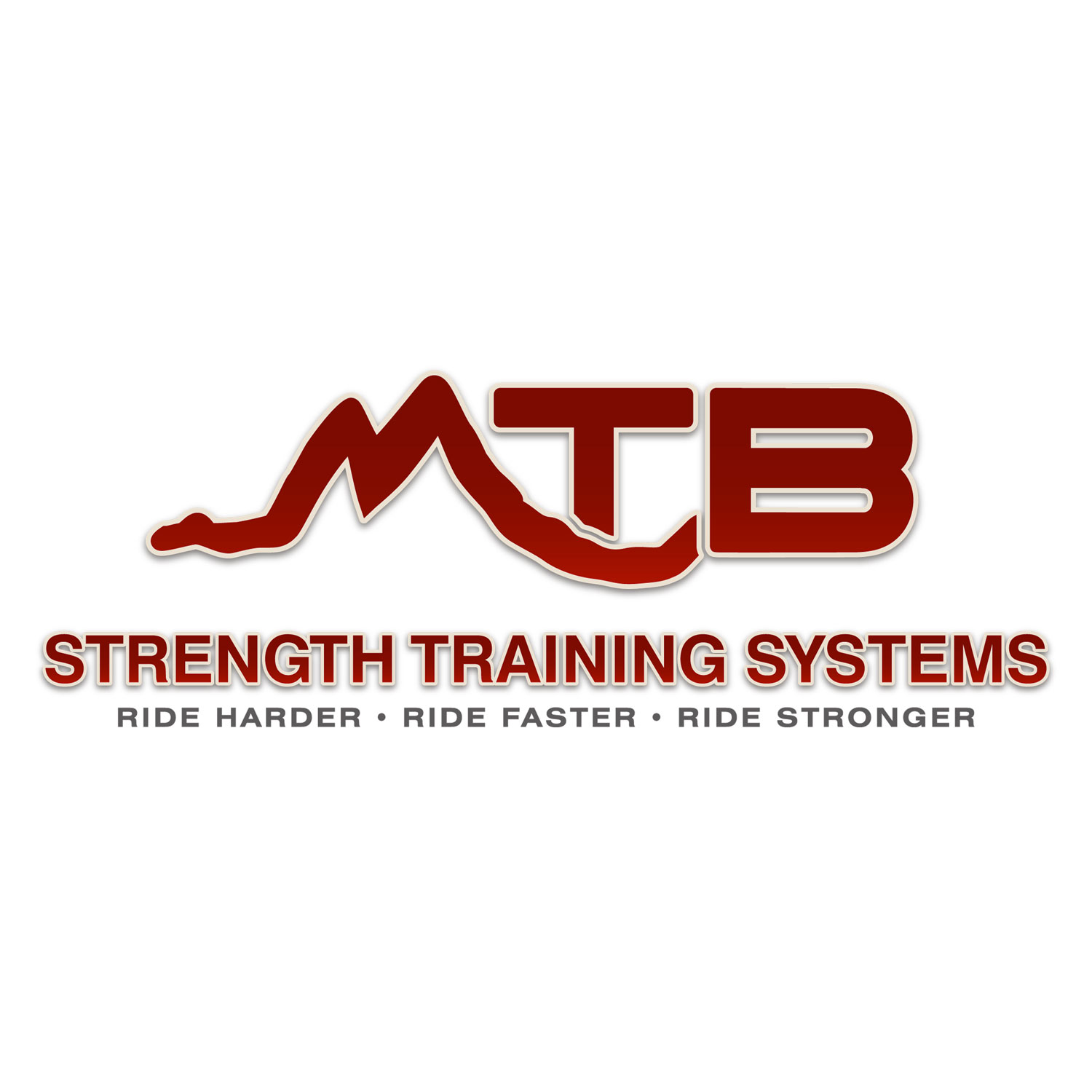Episodes
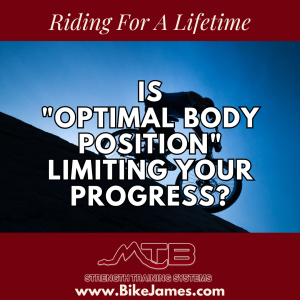
Friday Oct 25, 2024
Is "Optimal Body Position" Limiting Your Progress?
Friday Oct 25, 2024
Friday Oct 25, 2024
Perhaps no term gets thrown around more when talking about riding your bike than “body position”. It is recognized as being an essential part of your riding skills and performance, but what does the term really mean?
For something so important there is a lot of confusion surrounding it. Do you want to be in a low “attack position” or in more of an upright “throne position”? Do you want your weight on your feet with little to no weight on your hands or do you want to have weight and pressure through your hands?
It seems like the answers to these questions depend on who you talk to and what system they preach. There is a whole industry around this question, with qualified skills instructors from various backgrounds each trying to convince you that their version of body position is the best.
Well, what if I told you that the whole concept is kind of nonsense. I mean, obviously how you stand and hold yourself on the bike is important but the idea that there is an ideal body position when riding your mountain bike is incomplete at best.
The reason that I don’t like this term or the discussions around it is because it leads riders to believe that there is an ideal body position that they need to try and get into and maintain while riding. But this idea may work when doing drills in a parking lot, it isn’t how riding your bike works in the real world.
On the trail you are participating in a dynamic relationship between your body, the bike and the trail and these three things are rarely static. Conditions change all of the time and this means that your ideal body position is constantly shifting as well.
In fact, the worst thing you can do for your performance and safety on the trail is try and maintain an “ideal” body position. Instead, you want to change your body position to match the needs of the trail.
For example, let’s say that you are riding a section of trail that starts with a relatively flat section before feeding you into a technical rock garden that proceeds a short climb. What is the ideal body position for something like this? You guessed it, there isn’t one and you have to shift your body position to meet the needs of the moment.
When you are on the flat section you can get into a traditional position where you are keeping more weight on your feet than your hands and you are maintaining your position as you pedal. When you get to the rock garden you will need to preemptively shift your weight forward in anticipation of needing to perform a rear weight shift to unweighted or even lift your front wheel to help get over the first trail obstacle.
As you proceed through the rock garden you will need to dynamically shift your weight forward and backward to weight and unweight your front end to help you flow through the rocks and trail obstacles. Your body position will be very fluid and dynamic as you use your weight shifts to help navigate your bike through the technical trail section.
When you get through it and hit the climb you will want to stand up and shift your weight forward, putting weight on your hands and applying aggressive pressure through the rear wheel as needed for traction. If there are any obstacles on the climb you will also need to shift your weight back to float the front wheel over them before getting back into your aggressive climbing position.
So in this scenario you have gone from a “light hands, heavy feet” position to a dynamic position with a lot of front to back weight shifts and finally an aggressive standing position with your weight slightly forward on your hands. So what is the right body position?
The right body position changes depending on the demands of the moment. It isn’t based on someone’s theory of what the optimal position is and is certainly isn’t a static thing,
However, I see riders all the time who would try to ride through this same scenario trying to use and maintain a single body position (usually seated). This is usually due to someone telling them that it was the optimal position and that they need to stay in it as much as possible.
With that said, though, there are a few commonalities to the different good body positions you need to use on the bike. One of them is having a strong spine where you avoid leaning over at the low back and instead rely on your hips for leaning forward and shifting your weight back.
The other thing is to have your elbows in a strong position somewhere between being pinned to your ribs and being pushed out into an extreme “scarecrow” position. Like body position, the specific position your elbows should be in will change but being at the extremes is almost never the best place to be no matter what the “elbows out” crowd will lead you to believe.
Lastly, your feet should be in a mid-foot position so you are balanced at your feet and aren’t fighting the forward lean created by being on the balls of your feet. The mid-foot position allows you to more easily shift your weight forward or backward depending on the needs of the moment without committing your to one or the other like the ball of the foot position does.
If you have good spine, elbow and foot position then your body can act in the dynamic and fluid way needed to meet the needs of the moment. Of course, when you look at the average rider who is stiff through the hips and bends too much at the spine, has handlebars that are too wide and force the elbows into an unnaturally wide position and or perched on the balls of their feet you don’t see a strong, athletic body.
Instead you see a compromised, unbalanced body that struggles to find the flow needed to really enjoy riding. And this leads to people looking for the one body position that will cure their problems, which leads to the situation that most riders find themselves in now.
I truly believe that a lot of the demand for skills training is created by riders being placed in compromised, unbalanced positions on the bike through their lack of athleticism and bad advice from the cycling industry when it comes to equipment. If you put your body in a strong, balanced position on the bike it will naturally figure out a lot of things on its own - your body is an amazing learning machine when you give it the right context to learn in.
So don’t get caught up in trying to find and maintain the right body position because it doesn’t exist outside of the context that it is needed on the trail. Work on getting more athletic through a good mobility and strength training program and put yourself in a strong, balanced position on the bike through proper equipment choices and you’ll find that your body is able to do what it does best, which is to adapt to and learn from the movement challenges it encounters on the trail. Only then can you really benefit from skills training advice, but even then only if it doesn’t violate some basic movement principle along the way.
I believe that the best way to approach riding skills is to look at how the human body moves and then to apply that knowledge to the bike. If you are interested in learning more about this theory of mountain bike skills training you can download a free copy of my Underground Skills Training Manual, where I break down the movement patterns behind each of the major skills needed on the bike, how to improve them off of the bike and how to apply them to the bike.
If you have any questions about this post let me know, I’m always happy to help. And if you want to get some feedback on your riding and how to improve it through smart application of movement and training principles let me know. I'm taking on a few distance coaching clients this off season and I’d love to see if I can help you train and ride smarter.
Until next time…
Ride Strong,
James Wilson
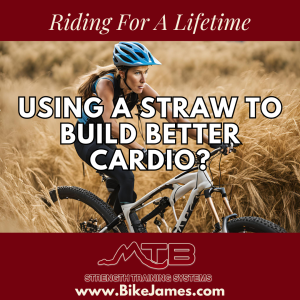
Saturday Oct 12, 2024
Using A Straw To Build Better Cardio?
Saturday Oct 12, 2024
Saturday Oct 12, 2024
If you have followed my newsletter for any length of time then you know that I am a huge advocate for better breathing habits. Breathing is the one lever that you can pull that will improve just about everything you do on the bike, including cardio, strength and even your skills.
As important as it is, though, few riders really focus on it as part of their training program. The good news is that it doesn’t take a lot of time and you don’t need fancy equipment.
In fact, a great way to train your breathing is to use a straw. Yes, the same thing you use to drink your favorite beverage when you’re out at a restaurant is also a great training tool for your breathing.
Just get a straw, have a seat and start to breathe through it. Just 5 minutes of this a few times a week will make an impact on several aspects of your breathing that will help you on the trail.
Breathwork training is an important part of MTB cardio training, especially as we get older. The good news is that it doesn’t take a lot of time or equipment - 5 minutes of breathing through a straw a few times a week can be enough to make an impact on it.
And if you want to learn even more about breathwork training for MTB, be sure to check out my Guide To Better Breathing For MTB. In it you’ll find how to assess your breathing and several drills and strategies to help you optimize your breathing for better health and performance.
Until next time…
Ride Strong,
James Wilson
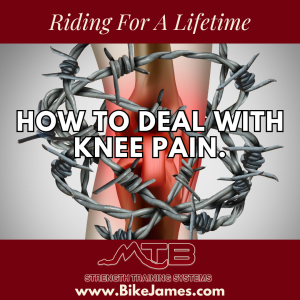
Thursday Sep 12, 2024
How To Deal With Knee Pain.
Thursday Sep 12, 2024
Thursday Sep 12, 2024
As you get older dealing with pain becomes more and more of a reality. Old injuries flare up, wear and tear add up and it all leads to more and more pain. Pain leads to time off or even surgeries and surgeries definitely lead to time off. Time off leads to loss of fitness and motivation which can lead to quitting.
So one of the best strategies for riding for a lifetime is to do everything you can to address pain early and to prevent it from getting worse. Prevention is the best plan of all because pain that you never had doesn’t need to be addressed at all.
In an effort to help more riders achieve the goal of Riding For A Lifetime I wanted to start sharing some tips on addressing pain for some of the most common problem areas faced by riders as we get older. In this post I wanted to start with one that almost every rider faces at some point, which is knee pain.
The knees take a beating on the trail. Everything we do on the trail involves the knees, from standing to seated efforts, from uphills to downhills and from techy trails to smooth flow trails, the knees are working hard to help us perform at our best.
The knees are an amazing structure that need to be both stable and mobile. Lacking in either of these things can lead to stress being placed on the wrong areas, which lead to pain and loss of performance.
On top of that, you need your feet to be supported properly so that your legs can move in the most functional way possible. Poor foot support is a major cause of knee pain both on and off the bike and an area that a lot of riders are confused about.
So let’s break down what each of these things means for us on the bike and how we can support our goals of having strong, stable knees that can take a pounding and come back for more.
Until next time...
Ride Strong,
James Wilson
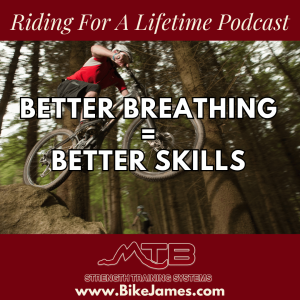
Thursday Sep 05, 2024
Better Breathing = Better Skills
Thursday Sep 05, 2024
Thursday Sep 05, 2024
While most people come into mountain biking worried about their fitness and cardio, it doesn’t take long to realize that your technical skills play a big role in your performance. Better skills mean you can ride faster and waste less energy, as well as helping keep you safe.
Over the last several years skills training has become extremely popular, with countless videos showing you how to improve your skills and a lot of skills camps popping up. In fact, if you’re reading this then I’d bet money that at some point you have done something to help improve your technical skills.
And while videos and camps can help a lot, there is one thing that most riders don’t think about that can make or break your ability to actually apply those skills to the trail - your breathing.
Better breathing can impact your performance and health in a lot of ways. While some of them are obvious, once you understand all of the ways how you breath impacts the body you realize that optimizing your breathing isn’t optional if you want to get the most out of yourself on the trail.
This is especially true if you are in the 40+ crowd. Breathing mechanics and smart use of specific breathing patterns isn’t something that declines with age and it allows you to maximize what you still have. While younger riders can use the physical advantages of youth to get away with a lot of bad habits we can’t do that and still perform at a high level on the trail.
So stop letting your breathing hold back your skills on the trail and start to incorporate these tips into your training and riding. And if you want even more info on optimizing your breathing check out my Guide To Better Breathing For MTB, where I show you how to assess your breathing and share even more ways to optimize your performance and health.
Until next time…
Ride Strong,
James Wilson
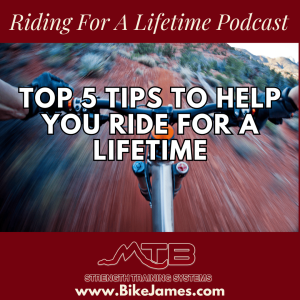
Monday Jun 24, 2024
Top 5 Tips To Help You Ride For A Lifetime
Monday Jun 24, 2024
Monday Jun 24, 2024
When I started MTB Strength Training Systems in 2005 I did it so I could share how functional strength training could help my fellow riders enjoy riding more. I was 30 at the time and my focus was on helping riders maximize their performance, which led to my involvement with several pro riders and teams.
10 years later I turned 40 and found my priorities changing. Now I was interested in longevity as well as performance and I was finding that my old training methods weren't having the same effect.
Now I'm quickly approaching 50 (holy shit, how did that happen?) and I've found that a lot of riders are also wanting to learn more about Riding For A Lifetime. I've been sharing a lot of my new training methods and programs over the last few years and they are always among my most popular posts.
I've shared a lot of great info on this subject over the last several years and I understand that it can be hard to keep track of all of it. So I wanted to put together my Top 5 Tips To Ride For A Lifetime.
This is just a quick summary of these concepts so be sure to check out the links at the bottom of this post to find more detailed posts. You can also find a video and audio summary of these concepts below.
Strength Training Is Essential
As we age, the physical decline of strength, power, and muscle mass becomes inevitable, affecting our overall physical capacity. This decline starts to accelerate after the age of 40, making strength training a non-negotiable part of any fitness regimen. Strength training has been proven to slow or even reverse these declines, enabling you to maintain a high capacity both on and off the bike.
To combat this, aim to incorporate strength training 2-4 times a week. This will not only enhance your biking performance but also set a strong foundation for Riding For A Lifetime.
Building and Maintaining Muscle Mass
One of the significant changes in strength training for the 40+ MTB rider is the increased need for muscle mass maintenance to combat sarcopenia, the age-related loss of muscle mass. Muscle mass acts as the engine for both strength and power and is closely linked to overall health and longevity.
Including bodybuilding elements in your workout plan—such as 3 sets of 10-15 reps and isolation work for the arms—can help maintain or even increase muscle mass. The more muscle mass you have, the longer it will take to decrease to a level that impacts your physical capabilities.
Isometrics for Safe and Effective Strength Building
Isometric exercises, which involve creating tension without movement, are excellent for building strength safely, especially for those dealing with past injuries. These exercises are also beneficial for high blood pressure, comparable to the effects of medication in some studies.
By incorporating isometric exercises such as Push-Up Holds and Lunge Holds for 30-90 seconds into your strength training program, you can build the stability needed for effective movement while minimizing injury risks.
Anti-Glycolytic Training (AGT) for Cardio
Traditional interval training is effective but it tends to be most effective for 6-8 weeks, after which it stops delivering the same results. Plus, it can be hard on the body and may negatively impact mitochondrial health, which is crucial for fitness and longevity.
Instead, consider Anti-Glycolytic Training (AGT), which involves short bursts of effort followed by near-complete rest. This method supports mitochondrial health and is particularly effective for activities requiring repeated high-intensity efforts like mountain biking. Aim for 5-10 seconds of work followed by 1 minute of rest for 10-30 minutes, using exercises like KB Swings, Jump Squats, or an exercise bike, 2-3 times a week.
Daily Mobility Work
Aging often leads to stiffness and reduced mobility, increasing injury risk and affecting your ability to display strength and endurance. For mountain bikers, this loss of mobility can also negatively impact technical skills and balance on the bike. This makes mobility training something that you must to in order to minimize your injury risk and help keep you moving well on and off the bike.
With mobility training it is better to do a little bit each day than to do a lot 1-2 times a week and nothing on the other days. Consistent daily mobility training, even just 10-15 minutes focusing on stretches for the shoulders and hips, can make a significant difference in maintaining and improving mobility.
Conclusion
Thank you for taking the time to let me share this information with you. For more in-depth insights, be sure to check out the links provided.
You can visit BikeJames.com for additional training tips and programs specifically designed for mountain biking. The 40+ MTB Rider Training Program was the first of its kind and shows you how to integrate all these elements into an effective 12 week training program.
If you have any questions about your own training journey feel free to contact me at james@bikejames.com, I'm always happy to help.
Until next time...
Ride Strong,
James Wilson
MTB Strength Training Systems
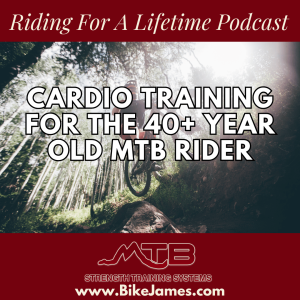
Friday May 17, 2024
Cardio Training For The 40+ Year Old MTB Rider
Friday May 17, 2024
Friday May 17, 2024
Over the last 5-10 years my cardio training program has changed a lot.
My old plan was to ride 5+ days a week and hit some hard intervals after my workouts. But now I can’t ride as much as I used to and my body can’t take the wear and tear of hard interval training for very long.
With this new reality I’ve found myself using different training methods that I did in the past to not only keep me fit for trail riding but also to improve my health and longevity. I’ve posted some podcasts and blog posts about these different training methods but I’ve never gone over them all together and explained how I combine them all into a comprehensive program.
In this episode of The Riding For A Lifetime Podcast I explain why I use the training methods I do and how you can use them as a part of your training plan.
You can find a great breathing resource to help you learn more by clicking here.
You can learn more about Anti Glycolytic Training by checking out this post/ podcast.
Until next time…
Ride Strong,
James Wilson
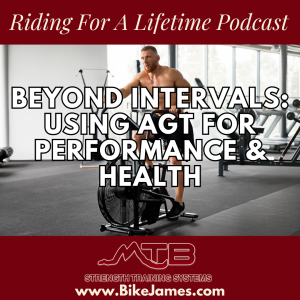
Friday Apr 26, 2024
Friday Apr 26, 2024
When it comes to building MTB specific cardio, the best method is to actually ride your bike - that is the most sport specific training you can do. However, there are times when you can’t ride as much as you would like or you want to focus on specific qualities that you need on the trail but don’t use enough on the trail to continue to improve.
There are also health benefits that you can get from a smart conditioning program that you can’t get from riding alone. This means that if you want to maximize your performance and your health then cardio training has to be part of your overall plan.
In this episode of the Riding For A Lifetime Podcast I share a new cardio training method that I feel has a lot of potential for the 40+ year old rider.
Let me know if you have any questions or need help getting started with this workout. This is just one way to go about it and I’ll be sharing more workout ideas with you as I get a chance to test them.
Until next time…
Ride Strong,
James Wilson
MTB Strength Training Systems
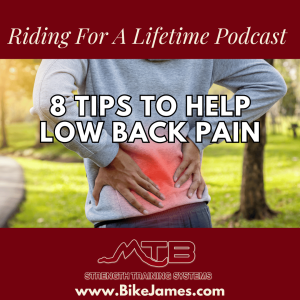
Friday Mar 08, 2024
8 Tips To Help Low Back Pain
Friday Mar 08, 2024
Friday Mar 08, 2024
Low Back Pain is one of the most common things that riders suffer from both on and off the bike. It can ruin the good time that mountain biking is supposed to provide for us and in extreme cases can even make riders quit riding.
Even more frustrating is that there doesn’t seem to be a consistent, predictable pattern with low back pain and it is often a mystery as to the specific underlying cause. But if you ignore it then it tends to get worse until you have to deal with it.
I have experience with Low Back Pain both as a trainer who has helped riders overcome it but also as someone who has suffered from it. A long time ago I tweaked my back trying to deadlift too much weight and if I don’t stay on top of it my back gets stiff and sore, plus I have to be conscious of it while training.
This journey to find solutions for myself and the riders I’ve worked with has led me to discover some things that I feel can help a lot of riders out there. A lot of these things aren’t your typical “stretch your hip flexors” advice you usually hear and they fill in some gaps that I think a lot of riders are missing in their attempts to fix their Low Back pain.
First, before we get to the specific advice, make sure that there isn’t something medically wrong with your back. Have a doctor check it out and see if there is something specific going on like a pinched nerve or a bulging disc.
But if there isn’t something specific wrong with your lower back and it just hurts at any time then there may be a few things you can do to help improve the situation.
Here are 8 things that I’ve found can help improve your Low Back Pain:
- Be aware of your breathing.
- Improve your Hip Flexor strength with Isometric Exercises.
- Improve Hip mobility.
- Improve Spinal mobility.
- Have a Warm Up and a Pre-Ride Routine.
- Stand up for High Tension efforts.
- Use Flat Pedals.
- Use a Strength Training Program that creates a well balanced body.
Be Aware Of Your Breathing.
How you breathe affects a lot of things in your body, including your lower back. Several studies have found a link between bad breathing habits and low back pain, IMO most likely due to the inability of the core to properly stabilize under load (poor core stability has also been linked to low back pain).
This means that you could be doing everything else right and still have low back pain. It’s a low hanging fruit that can make a big difference so you may as well make it a part of your overall strategy.
Good breathing will help to stabilize the midsection and reinforce good posture. You want to be aware of and practice good breathing habits on the bike, in the gym and during your everyday life.
You can check out this post to learn more about optimal breathing habits and how to assess and optimize your breathing habits.
Strengthen the Hip Flexors with Isometric Exercises.
The recommendation to strengthen the hip flexors might come as a surprise to some riders. We’ve been told for years that the problem was tight hip flexors and that we should avoid exercising them directly and focusing instead on stretching them.
I’ve found that this doesn’t consistently fix the problem and that there isn’t a direct correlation to a muscle being “tight” and it also being strong. A weak muscle creates its own set of problems that need to be addressed and in some cases, addressing the strength issue helps with the mobility/ ROM issues.
I’ve also found that using Isometric Exercises to strengthen the Hip Flexors offers a way to safely strengthen them, which can be an issue with movement based exercises. The 4 best Isometric Exercises that I’ve found for this purpose are the Single Leg Hip Flexor and Glute Bridge, Squat and Lunge.
Start with wherever you're at and work up to holding the weakest point of the movement that you can get into with good posture and breathing for 60-90 seconds. Do them 1-3 times a week, focusing on improving your ROM and breathing each week along with the time you are holding for.
Improve Hip Mobility.
Yes, you most likely do need to improve your hip mobility, you just need to focus on more than just the front of the leg (Quads and Hip Flexors). Your hips have 4 basic directions of movement and you want to do something to work on all of them.
I like to use good old fashioned static stretching positions along with my breathing and a little bit of movement to help me get deeper into the stretch. The 4 stretches I like to do are the Quad/ Hip Flexor Stretch, Hamstring Stretch, Glute Stretch and Butterfly Stretch.
You want to hold the stretches for as long as you can - 15 seconds is better than nothing and holding them for 5+ minutes might do you some good. In general, though, I recommend 30 seconds up to 2 minutes, 3-7 days a week.
Improve Spinal Mobility.
Another forgotten part of the low back pain problem is that your spine needs to be able to move freely and sometimes sticking points in that movement create excessive stress on the spine. Having a spine that moves freely that you can protect under load with tension is the ultimate goal and until both are achieved you may still be fighting low back pain.
The 3 movements I like for working on my Spinal Mobility are the Sun Salutation, Twisty Slaps and Stick Windmill. Be sure to avoid pain when doing these movements and to use your breathing to help stabilize the spine and improve your ROM.
BTW, if you don’t feel comfortable with spinal twists then just do the Sun Salutation, you’ll get a lot from it.
Have a Warm Up Routine and a Pre-Ride Routine.
Quality movement is pain free movement so your ultimate goal is to practice quality movement when you train and ride. Having a Warm Up and Pre-Ride Routine that focuses on improving your Hip and Spinal Mobility will help you to bring higher quality movement to your training and riding.
Sitting in a car or sitting and spinning your way to the trailhead will most likely create stiffness in those areas, which will decrease your movement quality. Doing a few mobility movements like the Sun Salutation, Twisty Slap, Windmill and Reverse Lunge to High Knee can set you up for better movement potential on the trail which will improve your performance, endurance and decrease the chance of low back pain.
Stand Up For High Tension Efforts.
The posture you put a lot of tension on matters. Standing Postures are better for High Tension Efforts - better posture, better chest position for breathing, better core engagement, more hip extension, co-contraction at the knee at the bottom of the pedal stroke and less strain on the neck to look up.
Seated Pedaling is good for Low Tension/ Recovery Efforts but the position and posture you are in is not good for creating a lot of tension. I know, you were told that Standing Pedaling is “less efficient” and to sit down on climbs to keep weight on the back tire.
Seated Pedaling feels easier but easier isn’t the same as “more efficient” - efficiency is a measurement of how much work is produced compared to the energy used to create it and in a lot of cases Standing Pedaling is actually “more efficient”.
Remember too that Standing Pedaling is a new skill and you aren’t very efficient at it, which makes it feel much harder. But once you use it for a while you get more efficient and it doesn’t feel as hard.
As far as keeping weight on the rear tire, you can keep weight on the back tire without having your butt on the seat. We’ve all seen examples of people climbing steep stuff while standing up so obviously it can be done and you don’t have to keep your butt on the seat when climbing.
Plus, you don’t want weight on your rear tire, you want well timed pressure. If you needed weight then Clydesdale sized riders would never break traction on climbs but we know that isn’t true so obviously there is more to it.
You want to use weight to create pressure, specifically pressure into the rear tire that is timed with your pedal stroke, and that is often done better from the Standing Position, especially on technical climbs.
A lot of riding related back pain is from too much reliance on seated pedaling. Break away from it and watch your performance improve and your pain go away.
Use Flat Pedals.
This isn’t which pedal system is the highest performance at the highest levels of competition, it is about which system is healthier for the body. As a 40+ year old rider odds are super high that you don’t pay your bills based on your riding performance and longevity is a priority for you.
Flat Pedals force you to use a more natural pedal stroke, which places the stress on the hips and not on unnatural pulling with the Hip Flexors and Low Back. They also allow for variability in your foot position and the pedal stroke that you can’t get when you are locking into the pedal in the same foot position every time you ride.
This variability has been found to correlate to fewer injuries and lower injury potentials and the current theory is that prefect, repeatable movement isn’t possible or desired for long term health.
Flat Pedals will take stress off of your lower back by allowing for more natural and more variable movement which, when coupled with Standing Pedaling, can make a huge impact on your lower back pain.
And with the risk of this sounding like an infomercial, the Catalyst Pedals I designed take this concept to its full conclusion by creating the most natural support possible for your foot, which further decreases pain and power and performance.
Use A Strength Training Program That Creates A Well Balanced Body.
Odds are pretty high that if you have low back pain then you haven’t been consistently following a strength training program that creates a well balanced body, especially if you have been riding a lot.
Maybe you haven’t been working out at all or maybe you’ve been doing something that creates more stress on the lower back, like programs that have you doing a lot of circuits to build cardio or “work capacity”, but either way you need to evaluate your overall approach to creating and maintaining a healthy, high performance body.
You can check out the podcast I did on Strength Training Basics For The 40+ Year Old Rider to learn more about what to look for in a good strength training program but as you get older this becomes more important.
So in conclusion, Low Back Pain is about much more than just stretching your Hip Flexors and by following this advice you can get your Low Back Pain under control and start to move in a better direction with how you move on and off the bike.
Until next time…
Ride Strong,
James Wilson
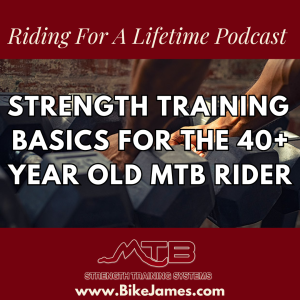
Friday Feb 16, 2024
Strength Training Basics For The 40+ Year Old Rider
Friday Feb 16, 2024
Friday Feb 16, 2024
As you get older, strength training changes from a “good to do” to a “must do” status. Losing your strength, muscle and power are all realities for the 40+ year old rider and strength training is the best way to slow that process down.
This is the #1 tactic for riders who want to do this for a lifetime - get and stay strong and you’ll avoid age-related physical decline for as long as possible.
Plus, improving your strength, power and muscle mass can help improve performance and reduce your risk of injury, so it helps now and acts as insurance against future losses. And while a lot of things can help, if you want to maximize your results there are some basic principles that the 40+ year old rider should be observing.
First, almost anything can “work” but it eventually stops working and it may not build the strength and fitness you need for riding. The goal is to follow a training program that will help us on the path towards riding for a lifetime: improving our MTB specific fitness and our overall longevity/ health.
With that in mind, here are some basic guidelines to help you with designing or choosing a training program.
Podcast Notes:
2-4 days a week is plenty and the specific number depends on how much you are riding and your ability to recover.
- The more you are riding and the more important your performance the fewer days you will lift.
- The more you are trying to focus on strength training/ building muscle the more often you need to lift.
- So this breaks down to 2 days a week during the riding season and 3-4 days a week in the off season depending on time available and goals.
You want to focus on big, compound movements but doing some isolation exercises won’t make you dysfunctional and can be beneficial in some cases.
- You want to focus on getting stronger or doing more volume with the main movement patterns and the exercises that train them - Squat, Hinge, Push, Pull, Carry and Rotate.
- I’d also break them up into unilateral and bilateral exercises
- But doing some isolation exercises like curls and tricep extensions can help with total body isometric strength as well as help with muscle building/ preservation.
You want to use a variety of set and rep schemes, with the bulk of them focusing on the 2-4 sets of 3-8 reps.
- 2-4 sets is enough volume to build strength and power without excessive fatigue.
- 3-8 reps covers the strength and power end as it gets into the hypertrophy end of things, giving you a variety of training stimuli to pick from.
- I’d recommend 80% of your training falling in this range and the other 20% falling into the higher rep ranges, going up to 20-30 reps.
- I don’t recommend spending time in the 1-2 rep range as the risk to benefit ratio isn’t high enough for me to be comfortable with recommending to most riders.
You don’t need to train to failure to see results and IMO it should be avoided as a 40+ year old rider.
- There is a lot of science that tells us that you don’t need to train to failure (or beyond) to see results.
- You can train to near failure and see the same results while also saving your body some wear and tear and also lowering your injury risk.
- Training to within 1-3 reps of failure is plenty to see results. This usually occurs when you start to slow down the concentric portion of the exercise, so as long as you go until you start to slow down then you are fine.
- Leaving 3-1 Reps In Reserve (RIR) also helps avoid injury since the closer you get to failure the more likely you are to see a technical breakdown that can lead to an acute or overuse injury.
Don’t use bodypart training and instead focus on total body or upper body/ lower body splits.
- Using bodypart training split (where you train the body by body parts like Chest, Back, Legs, Biceps, ect.) is a great way to build muscle but not the best way to build functional strength and power.
- Like I mentioned before, you want to focus on training movement patterns and so you want to divide your workouts based on those movement patterns.
- This means you can do a total body training split (where you train the lower and upper body on the same day) or an upper body/ lower body split where you focus on one area of the body each day.
- Total body training is usually better for minimizing soreness and maximizing recovery while the upper/ lower training split is better for creating more stress in one area, which can deliver better results with proper recovery or can help riders who recover really well and need more volume to stimulate progress.
- I suggest starting with a total body training split and then trying the upper/ lower training split if you feel you aren’t getting fatigued from your workouts.
Don’t Overdo Circuit Training
- You don’t want to turn everything into Circuit Training, where you do 3-4+ exercises in a row before repeating the Circuit for the specified reps.
- Circuit Training is great for getting a lot of work done in a short period of time but not great for building strength and power.
- You also don’t need to get that much done each workout - 3-6 exercises is plenty for most people. Better to focus more on less as you get older.
- Do Straight Sets (where you do one exercise at time) or Supersets (where you do two exercises in a row) for your main lifts and save the Circuit Training for your secondary lifts.
Use Isometrics to help round out your strength and safeguard your health.
- Isometrics are exercises where you create tension but don’t create movement.
- It is the basis for the stabilization strength you need to display strength and power from a strong, stable platform.
- It is also a great way to practice good breathing habits during high tension efforts, which translates very well to the trail.
- Isometrics have also been shown to help with high blood pressure and isometric strength has been linked to fewer TBIs and longevity.
- Use isometrics to train movement patterns that you can’t train with weights, either through lack of equipment or previous/ current injuries.
- If you are healthy then do one day of isomerics each week to round out your strength and longevity program.
Build up the intensity of your workouts over several weeks.
- You don’t want to come out and go as hard as you can in Week 1 of a new program. This gives you little room to improve and means that you will be maxing out your recovery abilities too soon.
- You want to start out easy in Week 1, moderate in Week 2 and then hard in Week 3.
- A good way to do this is to use the Reps In Reserve idea we talked about earlier. In Week 1 leave 3 RIR, in Week 2 leave 2 RIR and in Week 3 leave 1 RIR or go to failure if you must.
- Week 4 should be a deloading week so go back to 3 RIR and give your body a chance to recover from the hard week.
Change your workout every 4-8 weeks, with longer periods with the same workout being better.
- I’m convinced that we change workouts far too often and that the 40+ year old rider would do better with changing workout every 6-8 weeks.
- As long as you are able to progress (i.e. add load and/ reps) then there isn’t a huge need to change workouts.
- Longer periods of time with a workout means more chances to build on the skill behind the exercises you are doing, which means you build mastery and lower your chance of injury.
- The more you do a workout the less sore you get from it, leaving you feeling better when you’re riding or just during your everyday life.
Last Piece Of Advice Is Not To Lift For Social Media Or Look To It For New Ideas
- Lifting to look cool on SM is a young person's game.
- You don’t need to max out your Deadlift or try to jump up on a bunch of boxes.
- You also need to remember that a lot of the stuff you see on SM is there to get likes and look cool and probably isn’t the most productive use of your time.
- Stick with the basics and weigh the risk to benefit ratio when trying new things.
What does this look like in real life?
- I’ll link to a copy of my current training program here for you to check out. This is also the format I use in my online training program, especially the Ultimate MTB Workout Program.
- What you’ll see is 1 Power Exercise, 2 Main Exercises that use an upper body and a lower body lift around 3 secondary exercises that hit other movements or muscle groups I want to target.
- You’ll also see that I’m using Straight Sets for the first 3 exercises (Power and Main Exercises) and Circuit Training for the last 3 (Secondary Exercises).
- After 6-8 weeks of this routine I’ll switch it up by changing the exercises, sets and reps but sticking with the same basic outline.
- Switching between Sets and Reps like 3 X 3, 2 X 5 and 4 X 8 is a good way to use the suggested parameters from phase to phase.
These are the basic parameters I focus on with my own training and the clients I work with who are in the 40+ crowd. Focusing on doing fewer things but at a higher level of focus and mastery is one of the themes I like to push with these workouts.
You can and should train hard, you just have to be smarter about when and how you push yourself to the limit.
Until next time…
Ride Strong,
James Wilson
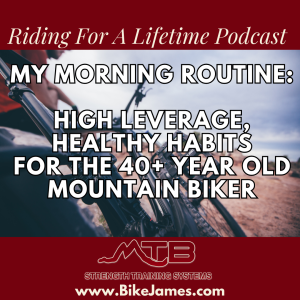
Saturday Jan 27, 2024
My Morning Routine: High Leverage, Healthy Habits For The 40+ Year Old Rider
Saturday Jan 27, 2024
Saturday Jan 27, 2024
In this episode of the Riding For A Lifetime Podcast I share with you my morning routine that helps me set my day on a good trajectory.
Maximizing your health and longevity becomes a big priority as you get older. You can get away with abusing your body in your 20’s and still being able to get after it but if you want to be able to perform well on a consistent basis into your 40’s and beyond you have to start making good daily habits a part of your routine.
Over the last several years I’ve developed a morning routine that I feel has helped me slow down the performance decline and maximize my results from training. Remember that training actually breaks your body down and how well you support the recovery process plays a big role in how hard you can train and what results you see from your training.
You can stream this episode or download the MP3 file by clicking the link below. You can also find the podcast on Itunes, Podbean, Spotify and all other major podcasting platforms.
Click Here To Stream This Episode or Download The MP3 File
The three things that I do every morning are…
- Hydrate with water and electrolytes, particularly sodium.
- Breathwork drills like Box Breathing or Super Ventilation + Breath Holds (a.k.a. Wim Hof style breathing).
- Cold water exposure.
First, hydration with sodium. After waking up I drink 16 ounces of water with a supplement called LMNT (I pronounce it Lemon T but it is supposed to be pronounced Element), which contains 1 gram of sodium along with 200 mg of potassium and 60 mg of magnesium.
Yes, I know that the FDA says that we should be limiting sodium intake but there are a lot of holes in their recommendations. Robb Wolf is a founder of LMNT and he has done a lot of great work on illuminating the difference between what we’re told by the FDA and what the research on sodium intake actually says.
While a fat, pre-diabetic person who doesn’t exercise and eats a lot of fast food probably doesn’t need extra sodium, if you are reasonably fit, workout on a regular basis and try to eat whole foods then odds are pretty high that you could stand to use more sodium in your diet.
Several studies have shown that there is a sweet spot for sodium intake between 4-6 grams a day that result in optimal health outcomes. Restricting sodium intake to less than this has been linked to higher incidents of high blood pressure and cardiovascular death (ironically the things we’re told that low sodium diets are supposed to protect us against).
By starting your day off with a gram of sodium you are hydrating your body in a healthy way since water without sodium can throw off fluid balance. Sodium helps to regulate fluid outside your cells and potassium helps to regulate fluid inside your cells so your body needs these minerals to maintain optimal fluid balance.
If you don’t get enough of these minerals from your diet then your body will leach them from your bones - along with calcium, which can weaken the bones and is something you want to avoid as an older athlete.
I usually take another 1-2 LMNTs throughout the day, especially if I’m doing something that causes me to sweat a lot, like going for a bike ride. If you have low energy, brain fog, muscle cramps or even recurring headaches it may be a result of low sodium intake, in which case increasing your sodium intake can have a massive impact on your health and performance.
The second thing I do is spend 10-15 minutes doing some kind of breathwork. I’ve talked a lot about how better breathing can impact your health, performance and even your mood and so starting the day with some focused breathing drills can make a big difference in how your day unfolds.
My two favorite breathing drills are Box Breathing or Wim Hof style breathing.
Box Breathing has you assign a time to the four parts of your breath - the inhale, hold at the top of the inhale, the exhale and the hold at the bottom of the exhale. By manipulating these four things you can create a change in the body’s internal chemistry, which will result in changes in the body over time.
For Box Breathing you start with 3 seconds for each part of the breath, so a 3 second inhale, a 3 second hold at the top, a 3 second exhale and a 3 second hold at the bottom. As this becomes easy you can add 1 second to each part of the breath cycle but make sure that you keep each part of the cycle the same length, hence the term “Box Breathing”. While your goal is to work up to 5 seconds or longer, you are getting results from whatever length works for you.
The Wim Hof style of breathing goes in the opposite direction, having you breathe as deeply and as quickly as possible for 30-40 breaths. On the last breath, do a comfortable exhale and then hold your breath.
When you feel the urge to breathe then take a deep breath in and hold once more, this time for 10-15 seconds. Then you breath out and start the process again, repeating 2-3 more times for a total of 3-4 rounds.
While they are very different and deliver slightly different overall results, both of these methods alter the blood chemistry, which results in adaptations in the body, and they both act as a form of meditation, which has also been shown to have positive health benefits.
If I had time I would do both of them every day at different times during the day. As it stands I can commit to doing one of them in the morning and so I like to alternate between the two breathing methods. I will say that the Wim Hof method is more stressful and so you want to make sure that you are in good health and then ease into it.
The last thing I do is take a shower and finish with 1.5-3 minutes of a cold water rinse. You can be a gangster and just take a cold shower but I like to shower like normal with hot water and then finish with the cold.
Cold exposure like this is part of a traditional way to harden the body and has been shown to have a lot of health benefits. Improved insulin sensitivity, improved mood and improved stress response are all documented benefits of cold water exposure and there are several other anecdotal benefits that people have reported as well.
Most of the studies have been done using cold water swimming or plunging but a lot of experts in this area say that you just need to get uncomfortably cold to see benefits. This is why a cold shower can work and is better than nothing. Doing a cold plunge is probably better - inducing a shiver response delivers unique benefits to cold exposure, which is easier with a cold plunge - just exposing yourself to cold water for a few minutes in the morning can have long term health benefits.
After that I’m ready to start my day. The biggest time investment is the breathing, drinking the LMNT doesn’t take long and I’m taking a shower anyway so I may as well finish with some cold water exposure. All told I’m about 30 minutes into my morning and I’ve already invested in some pretty good health habits.
Having daily habits like this helps you do something every day towards your goal of riding for a lifetime. You can’t workout every day but it is good to do something every day to keep momentum and help you feel like you are moving forward on a regular basis. Plus, it amplifies the results from your other training and riding.
Of course, this is just my routine and it won’t work for everyone. But even if you can’t follow this routine or find it doesn’t do anything for you then the takeaway message is to have something that you do everyday that moves you closer to your goals.
And if you have any questions or would like some advice on creating your own routine then let me know, I’m always happy to help.
Until next time…
Ride Strong,
James Wilson
MTB Strength Training Systems
p.s. Just like you need daily habits to help keep you fit and healthy, you need a strength training routine to offset the effects of aging and give you the strength needed to ride for a lifetime. In the 40+ MTB Rider Training Program I show you how to use the best strength training strategies to help you improve your riding fitness while maximizing your time and avoiding overuse injuries.
I also include a section on Breathwork and show you how to assess your breathing and several different training methods to help you improve your cardio in a unique way. If you need a workout plan that takes into account the realities of being a 40+ year old rider and gives you the tools and workouts to improve your health and fitness then click the link below to learn more and get your copy.
Click Here To Get Your Copy Of The 40+ MTB Rider Training Program

